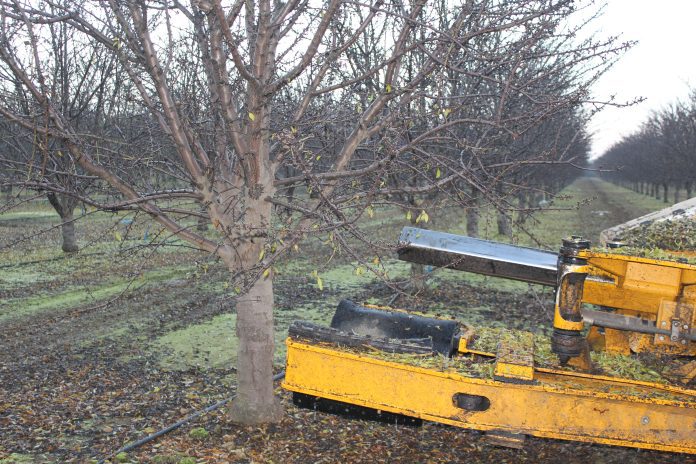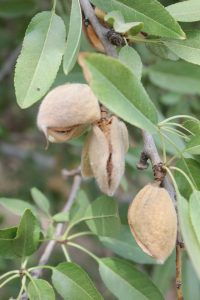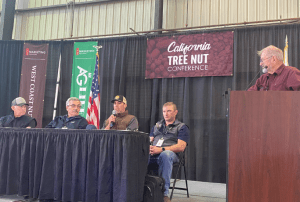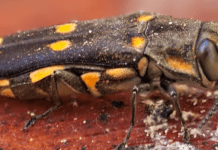
The guys with boots on the ground shared their control strategies and concerns about navel orangeworm in a roundtable discussion at the California Tree Nut Conference.
As growers, farm managers, PCAs and processors representative, they collectively presented a picture of the damage navel orangeworm can cause in almonds and pistachios, their views on control methods and why control is important.
Moderator Bob Van Steenwyk, UCCE entomologist, said California Department of Pesticide Regulation reports that pyrethroid use to control NOW has dropped as resistance issues have surfaced. The use of Intrepid was also trending down. More growers are using mating disruption in orchards to control this pest. Here is a look at some of panelists’ questions and answers.
Q. Advantages and disadvantages of MD to control NOW and do you use it?
Jimmy Nichols with Nichols Farm in Hanford said this control tool is good if the population of NOW in the orchard is low, which can be achieved by good orchard sanitation. Sanitation is an intensive operation at Nichols Farms, he said. It includes a mummy shake and then poling if necessary to remove all mummies. Mummies are blown off berms to the centers and ground up with a modified conditioner, leaving no overwintering sites for NOW.
Zack Raven, farm manager and grower relations with Keenan Farms, said even after adopting mating disruption in their orchards, they have continued with insecticide sprays as needed. When NOW pressure lessens, then they can cut the number of sprays.
Covering smaller block with MD is a challenge, Mel Machado with Blue Diamond noted, but taking a regional approach with neighbors is one answer.
“Mating disruption does work,” confirmed PCA Mike Strimska, “The disadvantage is the cost. Cost has come down, and the more acres involved, the better it works.”

Q. Have you observed resistance of NOW to the pyrethroids lambda cyhalothrin or bifenthrin or Intrepid?
Strimska said he has not observed resistance to Intrepid and does not use pyrethroids for NOW control. Raven said there is resistance to the pyrethroids.
Q. Do you breakdown the insects’ damage to positively identify the cause of the reject in your deliveries? In almonds, is your problem ants or NOW?
Machado noted that Blue Diamond offers the reject breakdown as a service, and he encourages growers seek this information on a representative sample.
Raven said determining what caused the damage is worth the trouble, considering bonus payments for quality and the loss due to rejects.
Strimska said due to MD use, trapping is not always a good indicator of NOW pressure.
Q. How many insecticide applications do you typically apply to maintain control and what is your timing?
It depends, said Strimska, on neighbors, MD and location. In blocks along I-5, he said pressure is high due to adjacent almonds, so they may apply four times, three on Nonpareil and one on pollinators. But he noted that in some years, only one is needed; two to three is typical.
Machado suggested aerial spraying for NOW to reach the top of the canopy where blanks split faster.
Raven said using MD has allowed them to reduce insecticide applications to two.
Q. If a grower can’t shake in a prompt manner, do you treat with another insecticide application?
Nichols advised to do it but to be confident that the shake will be late.
Don’t wait with Golden Hills, Raven said. The hulls can break down rapidly.
Q. Will NOW lay eggs on almonds after they have been shaken?
“That’s a lesson people learn the hard way,” Strimska said.
Machado said it really depends on the pressure in the orchard. Nichols confirmed that it does happen and is a reason why they send a representative load to compare with their stockpiled almonds.

Q. Does the NOW infestation in a neighbor’s crop influence your pest management decisions? How do you handle a dirty neighbor?
Communication and collaboration were the key answers to this question from round table participants. Strimska said egg traps will tell how many females are flying in; if using MD, the L2 PPO traps are used. If needed, timed border sprays can help.
Q. What is the impact of lower commodity pricing and increased production costs on NOW management?
“Figure it out,” Raven said. At $65 an acre to spray, you can recoup costs with MD. Most processors pay a premium for quality, he said. “After looking at the numbers, at 1% you can lose about $300 to $400 per acre depending on crop yield.”
Machado said Blue Diamond provides a site where growers can plug in yield and price, and it will show the loss at varying reject levels. Even with lower prices, he said that at 2% reject, the real figure is 4% as those nuts don’t make it out of the orchard.
Q. What impact have you observed with delayed harvest and NOW infestation?
“Delay is your number-one enemy,” Strimska stressed. He said delay in harvest will cause a sharp curve in damage. Raven said with the Golden Hills variety of pistachio, the faster hull degradation makes prompt harvest a must.
“They are vulnerable to infestation, so you have to be on top of harvest,” he added.
Strimska noted that with the recent harvest, it was difficult to get nuts off in time, and the delay made late insecticide sprays necessary. Mummy numbers were the highest he has seen, he said, and it is causing him to wonder about NOW pressure next year.
Q. Do you sanitize all of your orchards or only the susceptible varieties? What level of mummy nut removal do you strive to achieve during the winter and is flail mowing of the nuts required?
Machado said it is recommended that orchards with all varieties be sanitized to achieve the lowest number of mummies possible. Moisture helps with removal, he noted.
Some years, mummy shakes are difficult, Nichols added. Pruning crews that come in later can help with removal.
Q. With more emphasis being made toward regenerative farming and especially cover cropping, will this reduce the amount of mummy destruction? Would this create a higher-than-normal overwintering NOW population?
Strimska noted that increased soil moisture due to a good stand of cover crop does help with NOW overwintering mortality. When the stand is sparse and dry, survival is higher.
Nichols agreed that a good cover crop stand degrades mummies due to the higher moisture. In clay soils, he said that mummies break down quicker than in sandier soils. That is where the NOW pressure is highest, he said.
Cover crops do not work in every orchard every time, Machado said. Growers have to be flexible with this tool to achieve the goals they have.
Final thoughts on upcoming restrictions on groundwater pumping and the possible effect on NOW management: “Sick trees don’t hull split at the same time. This will make it harder to prevent NOW damage,” Machado said.
Raven predicted there would be more pea splits early in pistachios, opening the way for NOW infestation.










